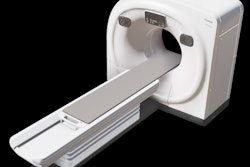In 2019, the U.S. Centers for Medicare and Medicaid Services (CMS) contracted with the University of California San Francisco (UCSF) to develop a quality measure focused on CT. Under the auspices of Alara Imaging, a measure steward entity established by the university, CMS plans to adopt the measure into its hospital and physician pay-for-performance programs beginning in 2025.
Administered CT radiation doses are highly variable across patients, radiologists, and hospitals throughout the U.S.1 Some patients receive excessive radiation doses without diagnostic benefit, needlessly increasing their personal risk of developing cancer. This inconsistency in how CT exams are performed represents a modifiable health risk, as doses can be reduced through auditing and feedback to hospitals and physicians.2
 Rebecca Smith-Bindman, MD.
Rebecca Smith-Bindman, MD.
There are three primary reasons why the doses are so variable. First, patients get assigned the wrong protocol -- for example, they are being seen for uncomplicated abdominal pain, and yet they get assigned to a four-phase CT scan. Second, the settings for the scan are not optimized and well-known dose reduction strategies such as modifying kV are not followed. And third, there are no clearly defined thresholds that, if exceeded, are considered excessive. While the American College of Radiology (ACR) publishes typical observed doses in its Dose Index Registry, there are few published doses that are defined as excessive, and without a defined passing dose, it is hard for a physician to calibrate doses.
To address CT radiation dose safety issues, in 2019 CMS invited CT researchers and experts to develop a measure that could be incorporated into its programs that use financial incentives to motivate clinicians and hospitals to improve clinical outcomes and patient safety. That year the University of California San Francisco (UCSF) won the opportunity to craft such a measure, designing it to identify when a CT exam is performed with unnecessarily high radiation dose and to include a measurement of global noise to ensure that financial incentives to lower dose do not undermine diagnostic value.
The purpose of the measure is to help practices optimize their doses. Practices can review their out-of-range values by CT category to identify areas where optimization efforts should be focused.
 Marc Kohli, MD.
Marc Kohli, MD.
Recognizing that appropriate radiation doses vary widely based on patient size, body part, and indication for imaging, each scan is assigned to one of 18 CT categories. Each CT category has separate thresholds for size-adjusted dose and image noise.3 Studies for which size-adjusted radiation dose or image noise exceed measure category thresholds are considered out of range, regardless of the underlying reason. In validation testing, most CT exams rated as out of range were due to radiation dose rather than image noise.
The measure underwent field testing across 17 hospital systems and one integrated outpatient organization, and the results were utilized as part of the National Quality Forum's decision to endorse the measures for use in judging hospital inpatient, hospital outpatient, and physician quality.4 Data from four of the most prevalent electronic health record (EHR) vendors and from four of the most prevalent CT vendors were represented in the testing set.
CMS required that this measure be designed as an electronic clinical quality measure (eCQM), the first radiology measure to be written in this format. Because the eCQM framework was not designed to calculate performance based on DICOM Radiation Dose Structured Report (RDSR) or image data, hospitals and physicians who desire to report on these measures must use CMS-approved software created by Alara Imaging to translate radiology data into an eCQM-compatible format. Alara Imaging offers the use of this software health systems and physicians free of charge through its Alara Medical Imaging Gateway; the software provides CMS with secure CT radiation dose measurements across a variety of patient populations so that results are accurate and comparisons meaningful. As measure steward, Alara is responsible for ensuring the measure is calculated and reported appropriately and consistently by every reporting institution and physician in the U.S.
The gateway automatically calculates the measure using data (size normalization and image noise) and DICOM RDSR (radiation dose), with imaging indication and exam performed in the form of CPT and ICD-10 codes respectively (CT Category). Sites can choose to send CT studies directly from CT machines, with a routing rule in PACS, or with a DICOM router. All calculations are performed without the data leaving the provider’s network. Alara Medical Imaging Gateway uses CT image, radiation dose, and indication data to calculate variables in three categories: CT Dose and Image Quality, Calculated CT Size-Adjusted Dose, and Calculated CT Global Noise. These variable results are eCQM-compatible and can be shared across a range of software platforms for measure calculation and reporting to CMS. Technical details regarding Alara Medical Imaging Gateway technical requirements and installation can be found here. Alara does not charge any integration fees and is actively developing integration standards with EHR, radiation dose management, and measure calculation vendors.
Rebecca Smith-Bindman, MD, is chief medical officer and co-founder of Alara Imaging and professor in residence of epidemiology and biostatistics, obstetrics, gynecology, and reproductive medicine at UCSF. Marc Kohli, MD, is a co-founder of the company, professor of radiology and biomedical imaging; medical director of imaging informatics for UCSF Health; and associate chair of clinical informatics for the department of radiology and biomedical imaging at UCSF.
The comments and observations expressed here are those of the authors and do not necessarily reflect the opinions of AuntMinnie.com.
References
- Smith-Bindman R, Wang Y, Chu P, et al. International variation in radiation dose for computed tomography examinations: prospective cohort study. BMJ. 2019 Jan 2:364:k4931. https://www.bmj.com/content/364/bmj.k4931.
- Smith-Bindman R, Chu P, Wang Y, et al. Comparison of the Effectiveness of Single-Component and Multicomponent Interventions for Reducing Radiation Doses in Patients Undergoing Computed Tomography: A Randomized Clinical Trial. JAMA Intern Med. 2020;180(5):666-675. doi:10.1001/jamainternmed.2020.0064. https://jamanetwork.com/journals/jamainternalmedicine/fullarticle/2763413.
- Smith-Bindman R, Yu S, Wang Y, et al. An Image Quality-informed Framework for CT Characterization. Radiology. 2022 Feb; 302(2):380-389. https://pubs.rsna.org/doi/full/10.1148/radiol.2021210591.
- National Quality Forum, Patient Safety, Fall 2021 Cycle: CDP Report, Technical Report, September 26, 2022. https://www.qualityforum.org/Publications/2022/09/Patient_Safety_Final_Report_-_Fall_2021_Cycle.aspx.
- Smith-Bindman R, Wang Y, Stewart C, et al. Improving the Safety of Computed Tomography Through Automated Quality Measurement: A Radiologist Reader Study of Radiation Dose, Image Noise, and Image Quality. https://journals.lww.com/investigativeradiology/abstract/9900/improving_the_safety_of_computed_tomography.194.aspx.



















